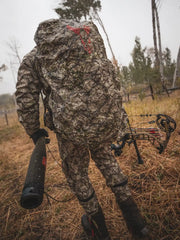In Greek mythology, the titan Atlas is charged with holding up the celestial heavens (including Earth) for eternity. But here’s a little-known fact about the famed strongman.
He’s a Badlands Pro Staffer and he knows about proper load distribution and pack fitting.
Sure, he’s usually depicted holding the globe on his bare back, but we know that he really uses a super-early prototype of the Badlands 2200 Pack for the task.
Be like Atlas. Be smart about how you carry your load with a properly fit pack.
“It’s a backpack, how hard can it be?” you may ask. While it’s not hard to do, fitting a pack is an often overlooked step. The end result of a bad fit varies from the inability to carry a load to the pack’s full potential, all the way to days of ice packs, heating pads and NSAIDs to ease that cripplingly achy back.
Our chiropractor is not a fan of this article. He wants a new boat.
Let’s get started.
Step One: Fit the pack to your torso
Proper backpack fit gets the weight off of your shoulders and down to your hips. Our close, personal friend Shakira said it best, “the hips don’t lie.” To make sure the weight is being properly distributed, we first have to get the length of the pack straps set right.
Start of by putting on the pack, but leave the weight belt unhooked. Grab your adjustment straps on each shoulder strap, and adjust until the hip belt is properly placed right above the hips.
Step Two: Adjust the hip belt
Now you can hook up the hip belt and pull on the adjustment straps to snug it up. You want this to be a solid fit, but not cinched so tight your feet start to turn blue.
You may not notice it at first, but we’ve flipped the way most pack makers position their straps. It’s awkward as all get out to try and pull a strap back behind you, so we set ours to be pulled forward. Small things make a big difference.
Step Three: Lift those loads
With the exception of our small day packs, you’ll find load-lifter straps on the top of the shoulder. Tug these tight so the weight is pulled into the body, which moves the load closer to your center of gravity. This makes it easier to carry more weight, and also makes it a ton easier to move around in the woods or the mountainside.
Ideally, you’ll actually see the pack shoulder straps lift up off of your body, leaving a noticeable gap. This means all the weight is down where it belongs.
Step Four: Connect the sternum strap
This is one of the most misused parts of any backpack. The sternum strap is not meant to be drawn tight or carry any load. It’s merely there to keep the shoulder straps together and not slip off. If you draw this too tight, it can impede your breathing and make it more difficult to do… well… anything.
No joke, friends and fellow hunters. A properly fit pack can make an amazing difference in the quality of your outing. You’ll notice it on the hike into the backcountry, but you’ll really appreciate it when you’re coming out with a pack full of venison, elk or whatever tasty protein you’re after.















